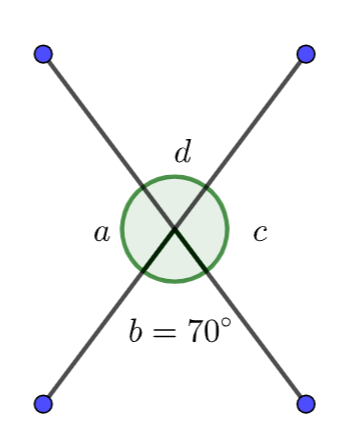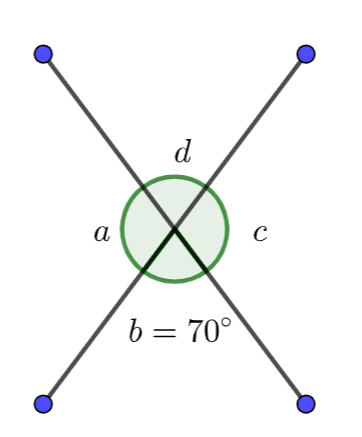
In the given figure


Answer
422.1k+ views
Hint: In this problem, we are given a diagram, where one of the angles is given and we have to find the other angels. We can see that we have
Complete step by step answer:
Here we are given a diagram in which

Here we can see that we have
We know that vertical angles are opposite to each other. When the two angles are across from each other they are called vertical angles, which are congruent so they are equal to each other. So, we can write as,
We can now use the supplement angels to find angle a and c.
We know that the sum of two angles is equal to
We can see in the diagram that angle d and c form a straight line whose angle is
We can now write it as
Similarly, angle a and c form a straight line whose angle is
Therefore,
Note: We should always remember that vertical angles are opposite to each other. When the two angles are across from each other they are called vertical angles, which are congruent so they are equal to each other. We should also know that the sum of two angles is equal to
Complete step by step answer:
Here we are given a diagram in which

Here we can see that we have
We know that vertical angles are opposite to each other. When the two angles are across from each other they are called vertical angles, which are congruent so they are equal to each other. So, we can write as,
We can now use the supplement angels to find angle a and c.
We know that the sum of two angles is equal to
We can see in the diagram that angle d and c form a straight line whose angle is
We can now write it as
Similarly, angle a and c form a straight line whose angle is
Therefore,
Note: We should always remember that vertical angles are opposite to each other. When the two angles are across from each other they are called vertical angles, which are congruent so they are equal to each other. We should also know that the sum of two angles is equal to
Latest Vedantu courses for you
Grade 11 Science PCM | CBSE | SCHOOL | English
CBSE (2025-26)
School Full course for CBSE students
₹41,848 per year
Recently Updated Pages
Master Class 9 General Knowledge: Engaging Questions & Answers for Success

Master Class 9 English: Engaging Questions & Answers for Success

Master Class 9 Science: Engaging Questions & Answers for Success

Master Class 9 Social Science: Engaging Questions & Answers for Success

Master Class 9 Maths: Engaging Questions & Answers for Success

Class 9 Question and Answer - Your Ultimate Solutions Guide

Trending doubts
Fill the blanks with the suitable prepositions 1 The class 9 english CBSE

Difference Between Plant Cell and Animal Cell

Given that HCF 306 657 9 find the LCM 306 657 class 9 maths CBSE

The highest mountain peak in India is A Kanchenjunga class 9 social science CBSE

What is the difference between Atleast and Atmost in class 9 maths CBSE

What is pollution? How many types of pollution? Define it




